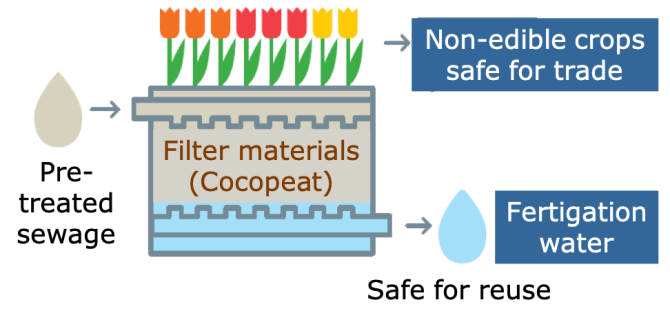
News
Science: Effective wastewater treatment by using Vital Urban Filter technology
Together with Dutch and Indian partners, PhD student Elackiya Sithamparanathan collaborates in the LOTUS-HR project, developing a so-called Vital Urban Filter (VUF). This filter is designed to boost wastewater treatment by a combination of biological, chemical and physical processes. Elackiya: ‘With the technology, we aim to treat urban wastewater, especially from Indian megacities to allow its safe re-use for irrigation and some household applications, such as toilet flushing.’
‘Here we test different designs of our Vital Urban Filter, Elackiya Sithamparanathan says. She points at a row of pots containing plants. ‘These plant species, growing on coco peat, have shown to be very suitable to be used in our new water cleaning filter.’ A network of thin black tubes supplies wastewater from a big tank into the coco peat. The interplay of different components in VUF, such as microbes, plants and filter materials results in the removal of pollutants resulting in cleaner water. By collecting and analyzing the treated water, the scientist measures the efficiency of the technology to remove various pollutants from the wastewater. A preliminary version of VUF installed at LOTUS pilot plant site, in New Delhi, India was recently visited by the Dutch King and Queen during their trade mission.
Improving water quality
Elackiya’s research aims at improving water quality in urban areas, such as India’s big cities. Many of those cities suffer from highly polluted water streams. For example, the 16 km long Barapullah drain in New Delhi is one of the biggest open sewer systems. It discharges around 125 million liters of wastewater into the Yamuna River every day. Existing treatment technologies have not been implemented, resulting in the Yamuna River being declared as a dead river. Nevertheless, people still use the river water for irrigation and religious purposes. To solve this big environmental issue, Indian and Dutch research institutes collaborate in the LOTUS project. Different institutes are responsible for different cleaning steps. After the pretreatment, using the well-known anaerobic UASB technology, pre-treated Barapullah drain water is further processed using algal(photo) bioreactors and Elackiya’s newly developed VUF.
The Barapullah drain in New Delhi: one of the biggest open sewer systems
Economic benefit
The VUF design (Fig. 1) is inspired by the traditional constructed wetlands,
but differs by a denser filter material, allowing intensified plant growth and
microbiological activity, and thus more efficient pollutant removal. Also, the use of ornamental plants instead of marsh plant species is different. These decorative plants have commercial value and thus provide an economic benefit to the system. However, it is vital that both the produced plants and the effluent are safe to use. Therefore, the scientist has performed several tests to understand basic processes about pollutant sorption, plant uptake and biodegradation in her VUF and uses this knowledge to improve the efficiency of the system. According to her studies, coco peat is one of the excellent filter materials that can be used: it performs really well, is readily available and inexpensive. Two decorative plant species, Periwinkle, and Syngonium, grow well in her system and are efficient pollutant removers in combination with coco peat.
Hybrid system
Although the VUF is still being perfectionated, an earlier design is already
operated on site to clean wastewater from the Barapullah drain in New Delhi. In this version, the water flows horizontally through the system. Anaerobic conditions in the horizontal flow system results in a better nitrogen removal, but limits other pollutant removal. ‘The vertical flow, used in our new design, has other benefits, like more aerobic conditions and thus a more efficient microbial activity and pollutant removal’, Elackiya says. ‘We are now working to design a hybrid vertical and horizontal flow system, where the benefits of the horizontal and vertical flows are combined, maximizing the performance.’ In April 2020, the new VUF is planned to be operative at the Barapullah drain. The scientist envisions the future implementation of the VUF as a decentralized
solution to treat various types of wastewater in different parts of the world.

Fig. 1. Schematic representation of the VUF design.
LOTUS-HR project is financed by the Department of Biotechnology, Government of India and TTW/NWO, The Netherlands. Collaborating research institutes are Wageningen University and Research, Institute of Ecology (NIOO-KNAW), Delft University of Technology, IHE Institute for water Education and VU University Amsterdam from the Netherlands, and Indian Institute of Technology Delhi, National Environmental Engineering Research Institute and The Energy and Resources Institute from India.